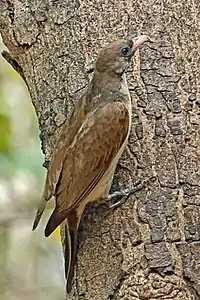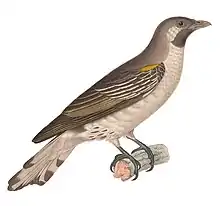Greater honeyguide
The greater honeyguide (Indicator indicator) is a bird in the family Indicatoridae, paleotropical near passerine birds related to the woodpeckers. Its English and scientific names refer to its habit of guiding people to bee colonies. Claims that it also guides non-human animals are disputed.
| Greater honeyguide | |
|---|---|
_(45663851145)%252C_crop.jpg.webp) | |
| Adult male in Tanzania | |
| Scientific classification | |
| Domain: | Eukaryota |
| Kingdom: | Animalia |
| Phylum: | Chordata |
| Clade: | Dinosauria |
| Class: | Aves |
| Order: | Piciformes |
| Family: | Indicatoridae |
| Genus: | Indicator |
| Species: | I. indicator |
| Binomial name | |
| Indicator indicator (Sparrman, 1777) | |
The greater honeyguide is a resident breeder in sub-Saharan Africa. It is found in a variety of habitats that have trees, especially dry open woodland, but not in the West African jungle.
Description
The greater honeyguide is about 20 cm (7.9 in) long and weighs about 50 g (1.8 oz). Like all African honeyguides, it has bold white patches on the sides of the tail. The male has dark grey-brown upperparts and white underparts, with a black throat. The wings are streaked whitish, and there is a yellow shoulder patch. The bill is pink.
The female is duller and lacks the black throat. Her bill is blackish. Immature birds are very distinctive, having olive-brown upperparts with a white rump and yellow throat and upper breast.
Behaviour and ecology
Diet

The greater honeyguide feeds primarily on the contents of bee colonies ("nests"): bee eggs, larvae and pupae; waxworms; and beeswax. (Honeyguides are among the few birds that can digest wax.) It frequently associates with other honeyguides at bees' nests; immatures dominate adults, and immatures of this species dominate all others. Like other honeyguides, the greater honeyguide enters bees' nests while the bees are torpid in the early morning, feeds at abandoned hives and scavenges at hives robbed by people or other large animals, notably the honey badger.
The greater honeyguide is known to guide people to the nests of wild bees.[2][3] A guiding bird attracts a person's attention with wavering, chattering "'tya' notes compounded with peeps or pipes",[4] sounds it also gives in aggression. The guiding bird flies toward an occupied nest (greater honeyguides know the sites of many bees' nests in their territories) and then stops nearby the nest. Honey-hunters then do a final search for the bee colony, and if deemed suitable, harvest honey from the bee colony through the use of fire and smoke to subdue the bees, and axes and machetes to expose the colony. After harvesting the honey, the honeyguide eats wax that is left.[5]
One study found that use of honeyguides by the Boran people of East Africa reduces their search time for honey by approximately two-thirds. Because of this benefit, the Boran use a specific loud whistle, known as the fuulido, when a search for honey is about to begin. The fuulido doubles the encounter rate with honeyguides.[2] In northern Tanzania, Honeyguides increased the Hadza's rate of finding bee nests by 560%, and led men to significantly higher yielding nests than those found without honeyguides.[3] Another study of the Yao honey-hunters in northern Mozambique showed that the honeyguides responded to the traditional brrrr-hmm call of the honey-hunters. The chances of finding a bee-hive were greatly increased when the traditional call was used. That study reported anecdotes from Yao honey-hunters that adult but not juvenile honeyguides respond to the specific honey-hunting calls.[6]
In African folklore, it is frequently noted that the honeyguide should be thanked with a gift of honey; if not, it may lead its follower to a lion, bull elephant, or venomous snake as punishment. However, “others maintain that honeycomb spoils the bird, and leave it to find its own bits of comb”.[5] While many depictions of the human-honeyguide mutualism emphasize honey-hunters graciously repaying the birds with piles of wax left in a conspicuous location, such behavior is not universal. The Hadza people of northern Tanzania frequently burn, bury, or hide the wax that lays with the intent of keeping the bird hungry, and more likely to guide again.[3] Some greater honeyguides have stopped this guiding behavior, or mutualism, in parts of Kenya, due to a loss of response from people in the area.[7][8]
Possible guiding of non-human animals

Many sources[9][10][11] say that this species also guides honey badgers. Sparrman noted in the 18th century that indigenous Africans reported this interaction, but Friedmann adds that no biologist has seen it. Friedmann quotes reports that greater honeyguides guide baboons and speculates that the behavior evolved in relation to these species before the appearance of humanity.[12] However, they state,
In addition to that listed by Friedmann (1955:41-47), the only recent record is of a greater honeyguide giving its guiding call to baboons at Wankie Game Reserve, Zimbabwe (C. J. Vernon, pers. comm.). However, Vernon did not see a positive response by the baboons to the honeyguide. No additional records of honeyguides and ratels have been reported since Friedmann (1955) and the first-hand accounts given in his review in support of this association are all of incomplete guiding sequences. No biologist has ever reported this association.
Dean and MacDonald go on to express doubt that honeyguides guide other animals and suggest that the behavior may have evolved with "early man". Later studies estimate that interaction between honeyguides and honey badgers likely occurs, "but is highly localized or extremely difficult to observe, or both".[13] It has also been acknowledged[14] that bee colonies are seasonally very common in Africa and ratels probably have no trouble finding them.
Another argument against guiding of non-human animals is that near cities, where Africans increasingly buy sugar rather than hunting for wild honey, guiding behavior is disappearing. Ultimately, it may disappear everywhere.[5]
Reproduction
In addition to being a predator of insects and a mutualist with its follower species, the greater honeyguide is a brood parasite. It lays white eggs in series of 3 to 7, for a total of 10 to 20 in a year. Each egg is laid in a different nest of a bird of another species, including some woodpeckers, barbets, kingfishers, bee-eaters, wood hoopoes, starlings, and large swallows. It is common for the female greater honeyguide to break the host's eggs when laying her own.[15] All the species parasitized nest in holes, covered nests, or deep cup nests. The chick has a membranous hook on the bill that it uses, while still blind and featherless, to kill the host's young outright or by repeated wounds.
References
- BirdLife International (2016). "Indicator indicator". IUCN Red List of Threatened Species. 2016: e.T22680616A92868613. doi:10.2305/IUCN.UK.2016-3.RLTS.T22680616A92868613.en. Retrieved 11 November 2021.
- Isack, H. A.; H.-U. Reyer (1989). "Honeyguides and honey gatherers: interspecific communication in a symbiotic relationship". Science. 243 (4896): 1343–1346. doi:10.1126/science.243.4896.1343. PMID 17808267. S2CID 4220280.
- Wood, B. M.; Pontzer, H.; Raichlen, D. A.; Marlowe, F. W. (2014). "Mutualism and manipulation in Hadza–honeyguide interactions". Evolution and Human Behavior. 35 (6): 540–546. doi:10.1016/j.evolhumbehav.2014.07.007.
- Short, L.; Horne, J. (2002). "Family Indicatoridae (Honeyguides)". In Del Hoyo, J.; Elliott, A.; Sargatal, J. (eds.). Handbook of the Birds of the World: Jacamars to Woodpeckers. Vol. 7. Lynx Edicions. ISBN 978-84-87334-37-5.
- Short, L.; Horne, J. & Diamond, A. W. (2003). "Honeyguides". In Perrins, C. (ed.). Firefly Encyclopedia of Birds. Firefly Books. pp. 396–397. ISBN 978-1-55297-777-4.
- Spottiswoode, C. N.; Begg, K. S.; Begg, C. M. (2016). "Reciprocal signaling in honeyguide-human mutualism". Science. 353 (6297): 387–389. doi:10.1126/science.aaf4885. PMID 27463674. S2CID 206648494. Retrieved 2020-08-14.
- Dean, W. R. J.; Siegfried, W. Roy; MacDonald, I. A. W. (1990). "The Fallacy, Fact, and Fate of Guiding Behavior in the Greater Honeyguide". Conservation Biology. 4 (1): 99–101. doi:10.1111/j.1523-1739.1990.tb00272.x. JSTOR 2385968.
- Friedmann, H. (1955). "The Honey-Guides". United States National Museum Bulletin. 208: 50.
- Attenborough, D. (1998). The Life of Birds. Princeton University Press. ISBN 978-0-691-01633-7.
- Estes, R. D. (1999). The Safari Companion: A Guide to Watching African Mammals. Chelsea Green. pp. 361–362. ISBN 978-1-890132-44-6.
- Zimmerman, D. A.; Turner, D. A. & Pearson, D. J. (1999). Birds of Kenya and Northern Tanzania. Princeton University Press. p. 406. ISBN 978-0-691-01022-9.
- Dean, W. R. J.; MacDonald, I. A. W. (1981). "A review of African birds feeding in association with mammals". Ostrich. 52 (3): 135–155. doi:10.1080/00306525.1981.9633599.
- van der Wal, J. E. M.; Afan, A. I.; Anyawire, M.; Begg, C. M.; Begg, K. S.; Dabo, G. A.; Gedi, I. I.; Harris, J. A.; Isack, H. A.; Ibrahim, J. I.; Jamie, G. A.; Kamboe, W.-B. W.; Kilawi, A. O.; Kingston, A.; Laltaika, E. A.; Lloyd-Jones, D. J.; M'manga, G. M.; Muhammad, N. Z.; Ngcamphalala, C. A.; Nhlabatsi, S. O.; Oleleteyo, T. T.; Sanda, M.; Tsamkxao, L.; Wood, B. M.; Spottiswoode, C. N.; Cram, D. L. (2023). "Do honey badgers and greater honeyguide birds cooperate to access bees' nests? Ecological evidence and honey-hunter accounts". Journal of Zoology. 321 (1): 22–32. doi:10.1111/jzo.13093.
- Short, L. & Horne, J. (2002). Toucans, Barbets and Honeyguides. Oxford University Press. pp. 473–480. ISBN 978-0-19-854666-5.
- Spottiswoode, C. N.; Colebrook-Robjent, J. F. R. (2007-07-01). "Egg puncturing by the brood parasitic Greater Honeyguide and potential host counteradaptations". Behavioral Ecology. 18 (4): 792–799. doi:10.1093/beheco/arm025. hdl:10.1093/beheco/arm025. ISSN 1045-2249.
Further reading
- Friedmann, Herbert (1955). The Honeyguides. U.S. National Museum (Bulletin 208).
External links
- BBC Radio 4's Natural Histories Honeyguide episode.[1]
- Greater honeyguide - Species text in The Atlas of Southern African Birds.
- YouTube Video: Honey Guide Bird(Amazing Partnership) Guiding humans to Beehive
- YouTube Video: BBC Talking to Strangers: honey birds
- Images at ADW
- Presenter: Brett Westwood; Experts: Claire Spottiswoode, Brian Wood, Lazaro Hamusikili, Orlando Yassene; Producer: Tim Dee (18 October 2016). "Honeyguide". Natural Histories. BBC. BBC Radio 4.
